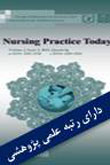فهرست مطالب

Nursing Practice Today
Volume:4 Issue: 3, Summer 2017
- تاریخ انتشار: 1396/08/08
- تعداد عناوین: 6
-
-
Pages 115-124Background and AimEvery pioneer healthcare-related organization should consider investment on enhancing the competency of the nurses. Since nurses would encounter patients from different cultures, cultural intelligence is considered an important capability for nurses. The aim of this study was to evaluate the relation between cultural intelligence and professional competency.
Methods & Materials: This correlational study was conducted on 274 nurses who were selected using multistage random sampling. The sample size was calculated using the Cochrans formula. Data gathering tools were Angs cultural intelligence questionnaire and Cowans professional competency questionnaire. The validity of the tools was evaluated using content and face validity and their internal consistency was measured using Cronbachs α (0.88 for cultural intelligence and 0.89 for professional competency). Data were analyzed using descriptive statistics, Pearson correlation test and multiple regressions.ResultsResults showed that the mean score of professional competency among the nurses was 226 ± 17.3 and of cultural intelligence was 88.2 ± 11.32. The dimensions of metacognitive (r = 0.568, pConclusionConsidering the relation between cultural intelligence and professional competency of the nurses and the predictive power of some of its dimensions in estimating the professional competency of the nurses, it seems that the concept of cultural intelligence could be attended for improving and enhancing the quality of provided cares.Keywords: professional competency, cultural Intelligence, nurses -
Pages 125-133Background and AimGastrointestinal cancer is one of the most common malignancies worldwide. Patients who undergo chemotherapy due to gastrointestinal cancer need to cope with the problems they face, as it will increase their quality of life and ability to take care of themselves. Therefore, it is important to determine patients coping methods and their effects on nursing care. This study aims to explore the problems faced by outpatients after receiving chemotherapy due to gastrointestinal cancer and the methods they use to cope with such problems.
Methods & Materials: This cross-sectional study was conducted in outpatient chemotherapy units of the Divisions of Medical Oncology at two medical school hospitals of a state university in Ankara, Turkey, between February and September 2011. A questionnaire developed by the authors in line with the literature to determine the patients demographic characteristics, the problems they face, and their methods to cope with the adverse effects of chemotherapy and the Nightingale Symptom Assessment Scale were administered to 88 patients with gastrointestinal cancer admitted to the outpatient chemotherapy units to receive their third course of chemotherapy who met the inclusion criteria.ResultsThe patients mostly experienced nauseavomiting (73.9%), malaisefatigue (88.6%), loss of appetite (69.3%), and changes in taste and/or smell (54.5%) after chemotherapy. The methods most frequently used by the patients to cope with these problems were taking antiemetic drugs (46.6%), resting frequently/spending the day lying or sleeping (87.5%), and taking care of oral hygiene (27.3%). The general well-being was very good for 13.6%, good for 67%, fair for 15.9%, and poor for 3.4% of the patients. Of them, 40.9% received and 59.1% did not receive education on the adverse effects of chemotherapy.ConclusionIndividualized education programs on the adverse effects of therapy and the ways to cope with these effects should be provided to the patients before and during the therapy at the outpatient centers.Keywords: cancer, chemotherapy, nursing care, side effects -
Pages 134-142Background and AimMusculoskeletal diseases are accounted for a major part of occupational diseases, which threaten the health and performance of medical staff, especially operating room nurses. Considering the importance of this matter, the aim of the present study was to determine the prevalence of musculoskeletal disorders among operating room nurses in educational hospitals affiliated with Iran University of medical Sciences in 2016.
Methods & Materials: The present study was a descriptive analytical study. The samples for the present study were 133 operating room nurses who were selected using census sampling method. Data were gathered using Nordic Musculoskeletal Questionnaire and a researcher-made questionnaire and analyzed using independent t-test, chi square test and SPSS software version 22.ResultsResults showed that the prevalence of musculoskeletal disorders during the past 12 months was 41.4% in the neck, 34.3% in the shoulders, 11.3% in the elbows, 35.3% in the wrists, 42.1% in the back, 61.7% in the waist, 16.5% in the buttocks, 46.6% in the knees and 29.3% in the feet. Results of chi square test showed a significant relation between the field of surgery and the prevalence of musculoskeletal disorders (p = 0.047). Independent t-test revealed a significant relation between the working history and occurrence of musculoskeletal disorders (p = 0.002).ConclusionResults revealed the high prevalence of musculoskeletal disorders among operating room nurses and so, it is recommended to provide educational courses for teaching the principles of ergonomics and correct method of standing and also, Regulations for decreasing the working hours of the personnel.Keywords: musculoskeletal, surgery, operating room, nordic -
Pages 143-153Background and AimBesides the disease severity of Psoriasis, the quality of life is highly important; however, the relationship between the two is not clear. This study was carried out with the aim of determining the relationship between the quality of life and disease severity in patients with psoriasis.
Methods & Materials: ýThis cross-sectional study was conducted on 99 patients with psoriasis who referred to Razi hospital, Tehran University of Medical Sciences, Tehran, Iran in 2015. The patients who met the inclusion criteria of the study were recruited by convenience sampling. The data was collected, using Dermatology Quality of Life Index and þPsoriasis Area Severity Indexþ. Data was analyzed using Pearson correlation coefficient, independent t-tests, one-way ANOVA, and linear regression analysis via SPSS v.21 at a significance level less than 0.05.ResultsýThe mean scores (standard deviation) of psoriasis severity and total quality of life were 14.26 (9.41) and 14.13 (6.47), respectively. There was a positive, strong, and significant relationship between psoriasis severity and total quality of life (r= 0.622, PConclusionýAs the results revealed, the higher the psoriasis severity indicated the lower the quality of life. This study showed the significance of addressing quality of life along with psoriasis severity in the process of assessing and treating patients. The results can serve as a foundation for interventional studies aiming at improving the quality of life in patients with psoriasis.Keywords: disease severity, psoriasis, quality of life -
Pages 154-163Background and AimSexual dysfunction is a common matter among women which has a significant effect on humans life. Various methods have been evaluated for encountering and treatment of sexual dysfunction. Considering the effects of saffron and shortage of conducted studies in this field, the aim of the present study was to evaluate the effect of saffron on sexual dysfunction in women of reproductive age.
Methods & Materials: The present clinical trial was conducted on 69 women of 18 to 39 years old who referred to the health centers of the Arak University of Medical Sciences in 2013. Participants were selected using continuous sampling method and were randomly allocated into two groups of intervention and control. The intervention was performed as using saffron extract capsule for 8 weeks and comparing it to consumption of placebo capsules. The status of participants sexual performance was evaluated using Female Sexual Function Index before the intervention and four and eight weeks after the start of the intervention. Data were analyzed through SPSS software using chi square test, independent t-test and Cochrane test.ResultsResults showed no significant difference between both groups regarding their sexual dysfunction at the beginning of the study. Comparing the two groups of intervention and control four weeks after the start of the intervention showed a significant difference between their excitement and desire. However, eight weeks after the start of the intervention, the difference between both groups regarding their total sexual dysfunction and all of its aspects except for lubrication and dyspareunia was statistically significant.ConclusionConsidering the effect of saffron on improvement of womens sexual performance and also considering the safety of this herbal drug, saffron could be used for improvement of sexual performance in women of reproductive age.Keywords: women's sexual performance, Saffron extract, reproductive ages, sexual dysfunction


